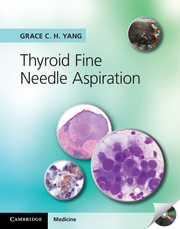Book contents
- Frontmatter
- Dedication
- Contents
- Preface
- 1 Techniques and approaches to ultrasound-guided fine needle aspiration
- 2 Nodular goiter and mimickers
- 3 Follicular neoplasm and mimickers
- 4 Hürthle cell neoplasm and mimickers
- 5 Follicular variant of papillary carcinoma
- 6 Thyroiditis and mimickers
- 7 Papillary thyroid carcinoma and variants with papillae and mimicker
- 8 Papillary thyroid carcinoma, uncommon variants, and mimicker
- 9 Clear cell and mucinous thyroid tumors
- 10 Poorly differentiated thyroid carcinoma
- 11 Anaplastic thyroid carcinoma
- 12 Medullary thyroid carcinoma
- 13 Miscellaneous benign lesions
- 14 Metastatic thyroid carcinoma
- 15 Metastatic and secondary tumors to the thyroid
- 16 Ancillary tests
- Index to case histories
- Index to ultrasound and Doppler images
- General index
- References
11 - Anaplastic thyroid carcinoma
Published online by Cambridge University Press: 05 September 2014
- Frontmatter
- Dedication
- Contents
- Preface
- 1 Techniques and approaches to ultrasound-guided fine needle aspiration
- 2 Nodular goiter and mimickers
- 3 Follicular neoplasm and mimickers
- 4 Hürthle cell neoplasm and mimickers
- 5 Follicular variant of papillary carcinoma
- 6 Thyroiditis and mimickers
- 7 Papillary thyroid carcinoma and variants with papillae and mimicker
- 8 Papillary thyroid carcinoma, uncommon variants, and mimicker
- 9 Clear cell and mucinous thyroid tumors
- 10 Poorly differentiated thyroid carcinoma
- 11 Anaplastic thyroid carcinoma
- 12 Medullary thyroid carcinoma
- 13 Miscellaneous benign lesions
- 14 Metastatic thyroid carcinoma
- 15 Metastatic and secondary tumors to the thyroid
- 16 Ancillary tests
- Index to case histories
- Index to ultrasound and Doppler images
- General index
- References
Summary
Clinical features
Anaplastic thyroid carcinoma, also termed undifferentiated carcinoma, is a lethal thyroid cancer with a five-year overall survival rate of ~7% and medium survival of ~6 months. Anaplastic carcinoma comprises <5% of all thyroid malignancies and occurs mainly in the elderly; only 25% of patients are younger than 60 years. The classic presentation of anaplastic carcinoma is a rapidly growing neck mass. Tumor volume may double within one week. Prognosis depends on the extent of tumor at presentation. Most of the patients with the classic presentation die within a year, typically as a result of tumor involvement of vital neck structures. Localized tumors (<5 cm), especially small foci of anaplastic carcinoma that can be detected only microscopically on thyroidectomy performed for other reasons, have a much better prognosis. Although radical resection is contraindicated, resection without inducing significant morbidity can be considered for good-risk patients with resectable tumors. It provides an effective form of palliation with potential cure when combined with postoperative radiotherapy and/or chemotherapy.,
The incidence of anaplastic carcinoma decreased by 22% from 1973 to 2003, which is attributed to the early detection and successful treatment of papillary carcinoma. During this time period, the incidence of follicular carcinoma remained stable, while the incidence of papillary carcinoma increased by 189% (the incidence of the follicular variant alone increased by 173%).
- Type
- Chapter
- Information
- Thyroid Fine Needle Aspiration , pp. 363 - 375Publisher: Cambridge University PressPrint publication year: 2013

